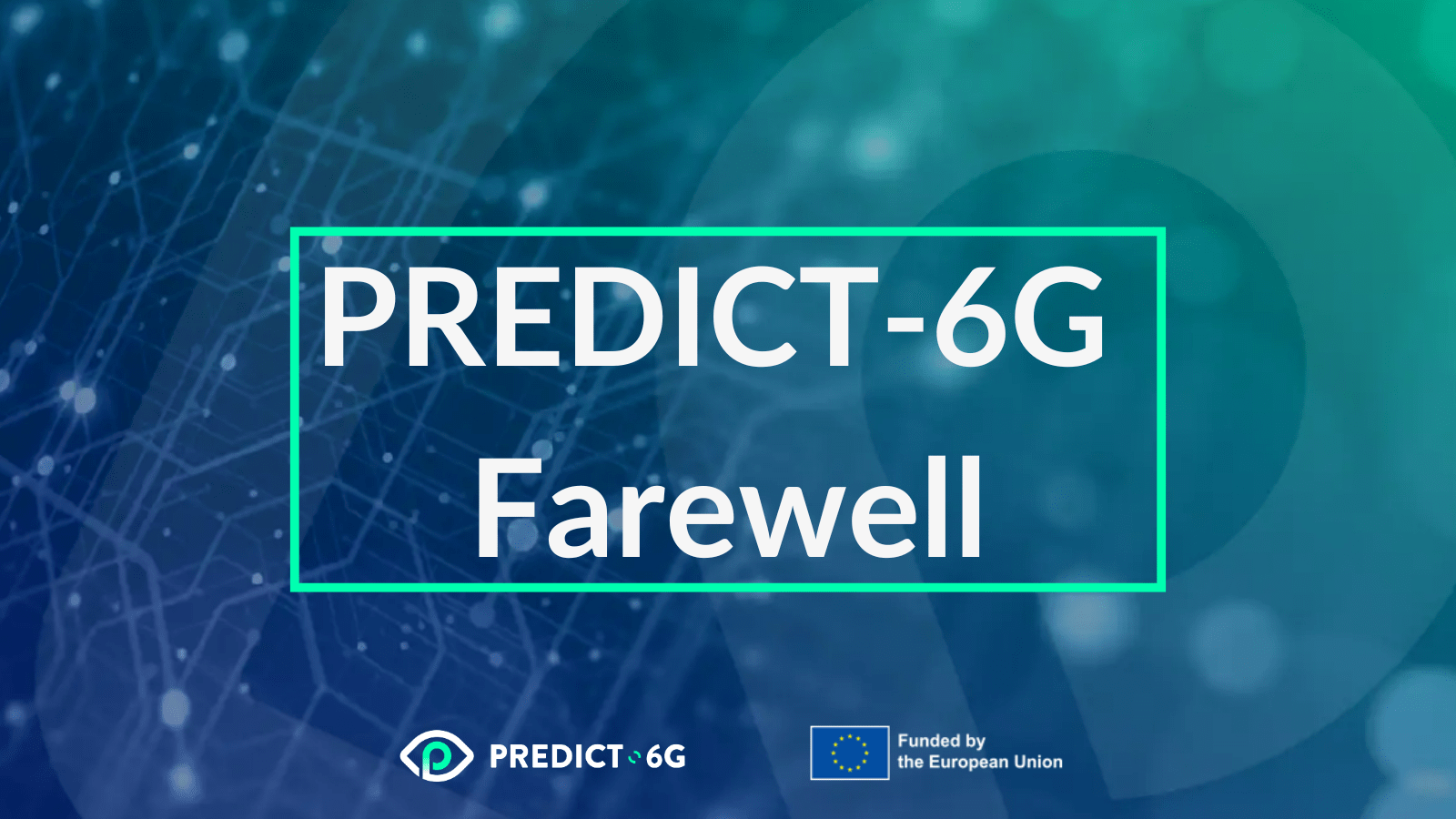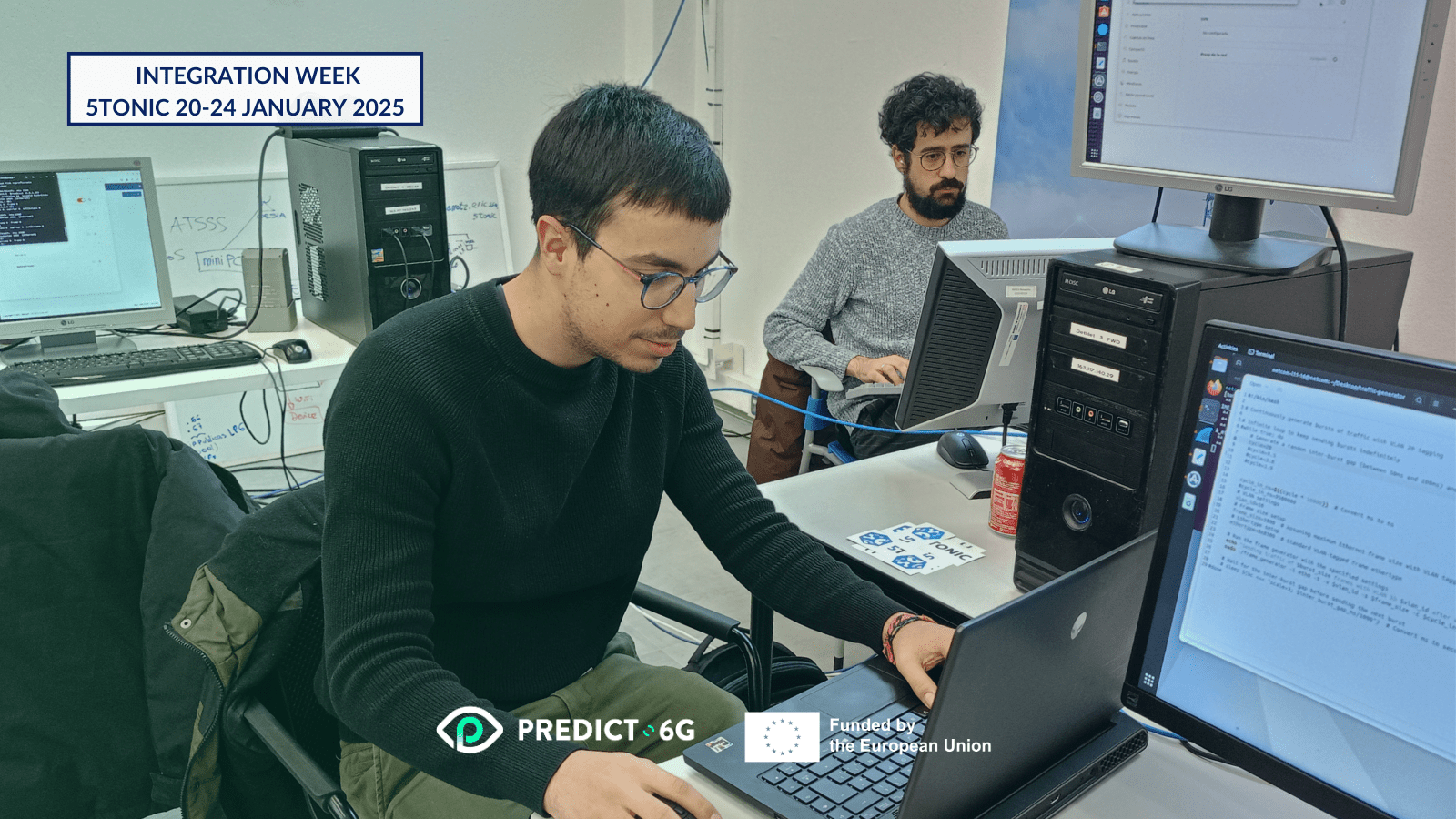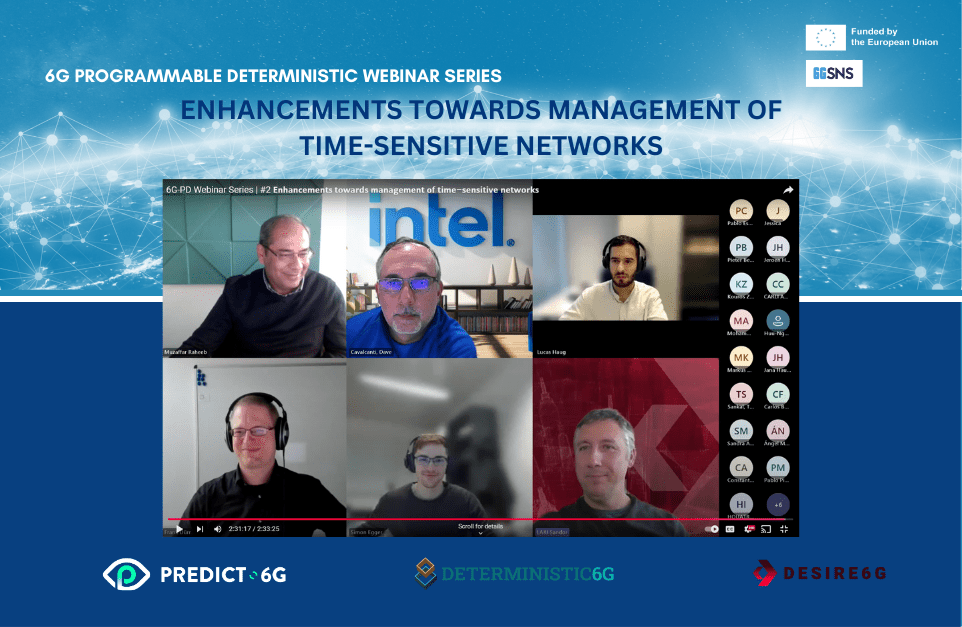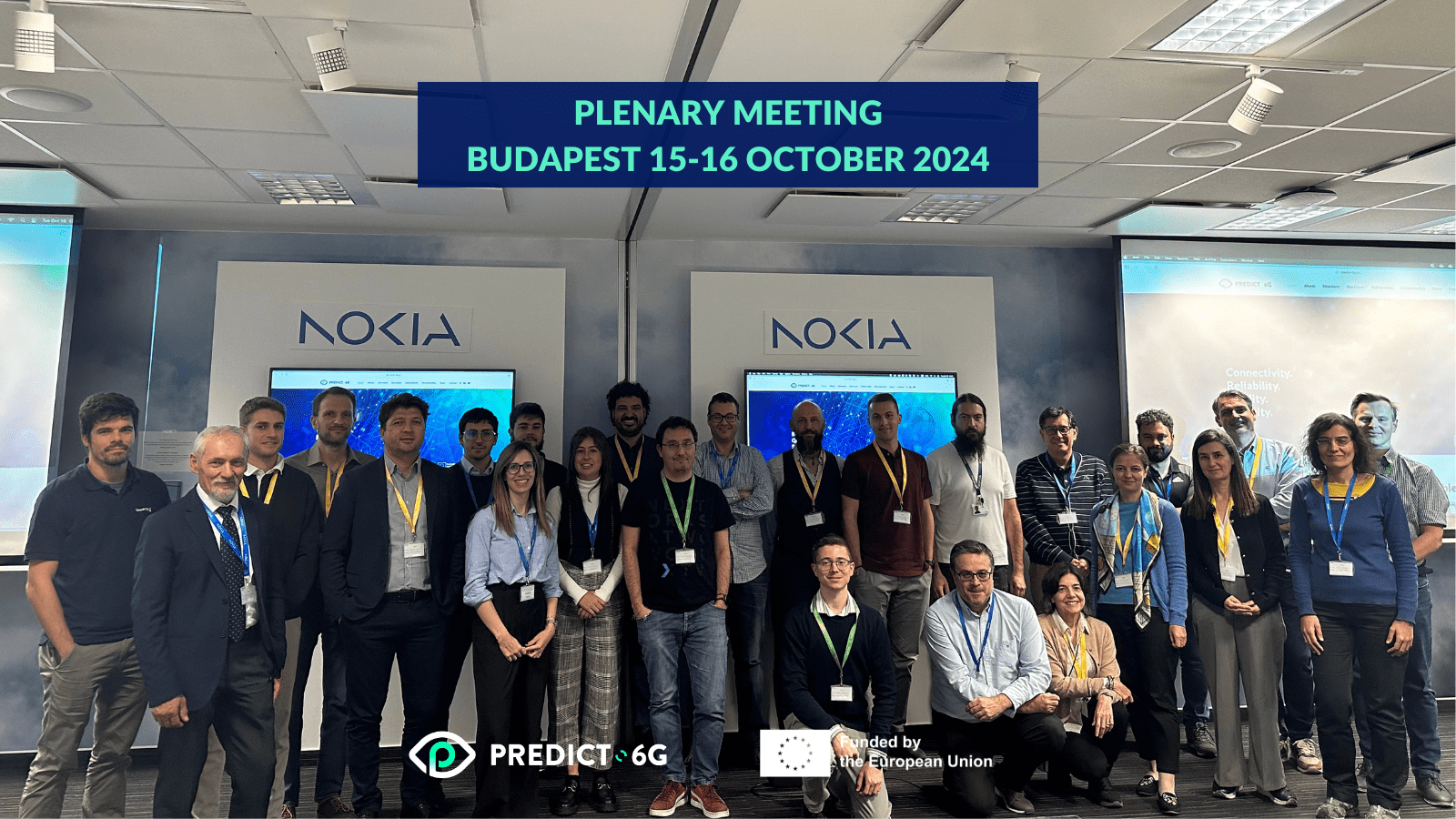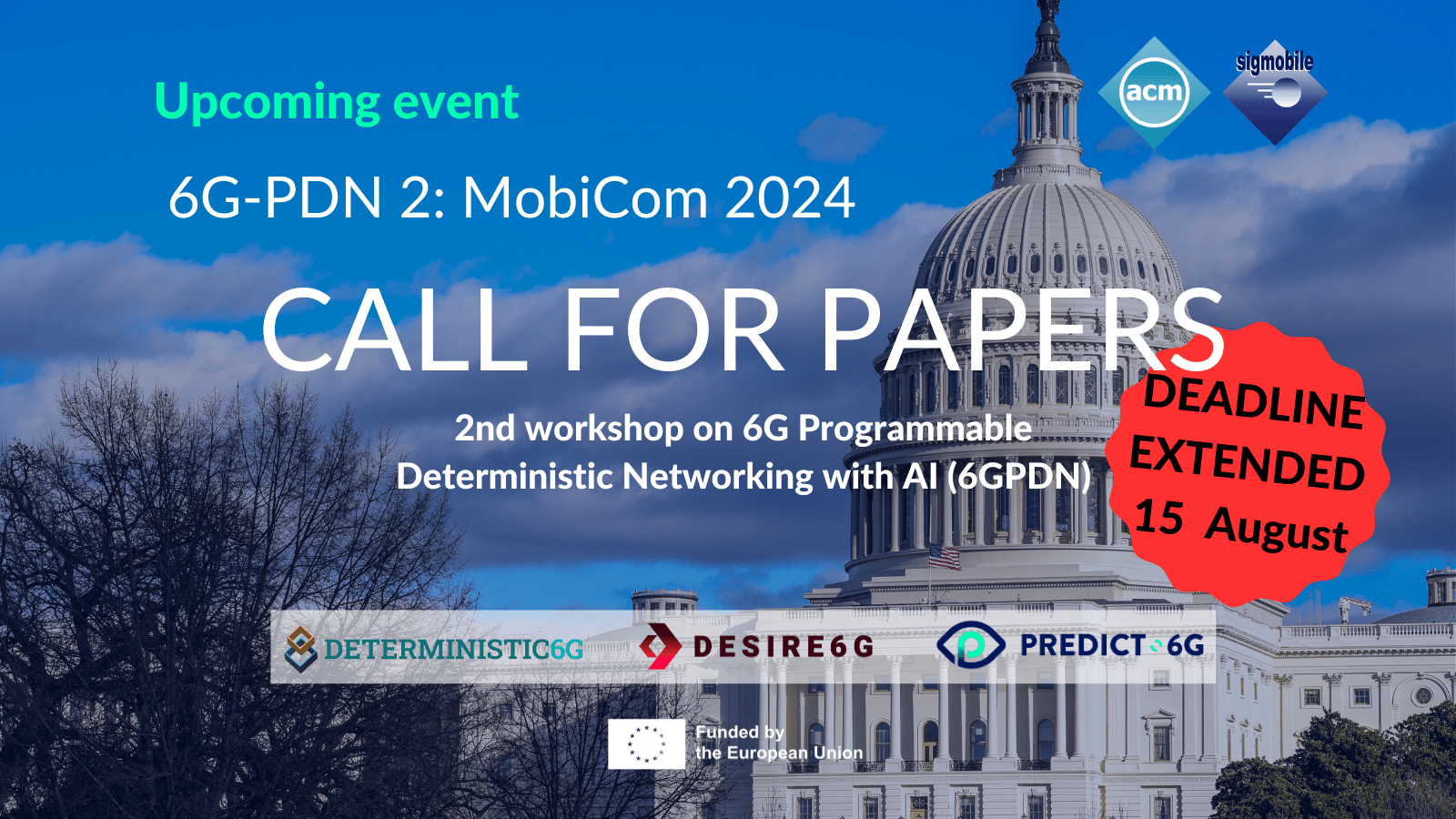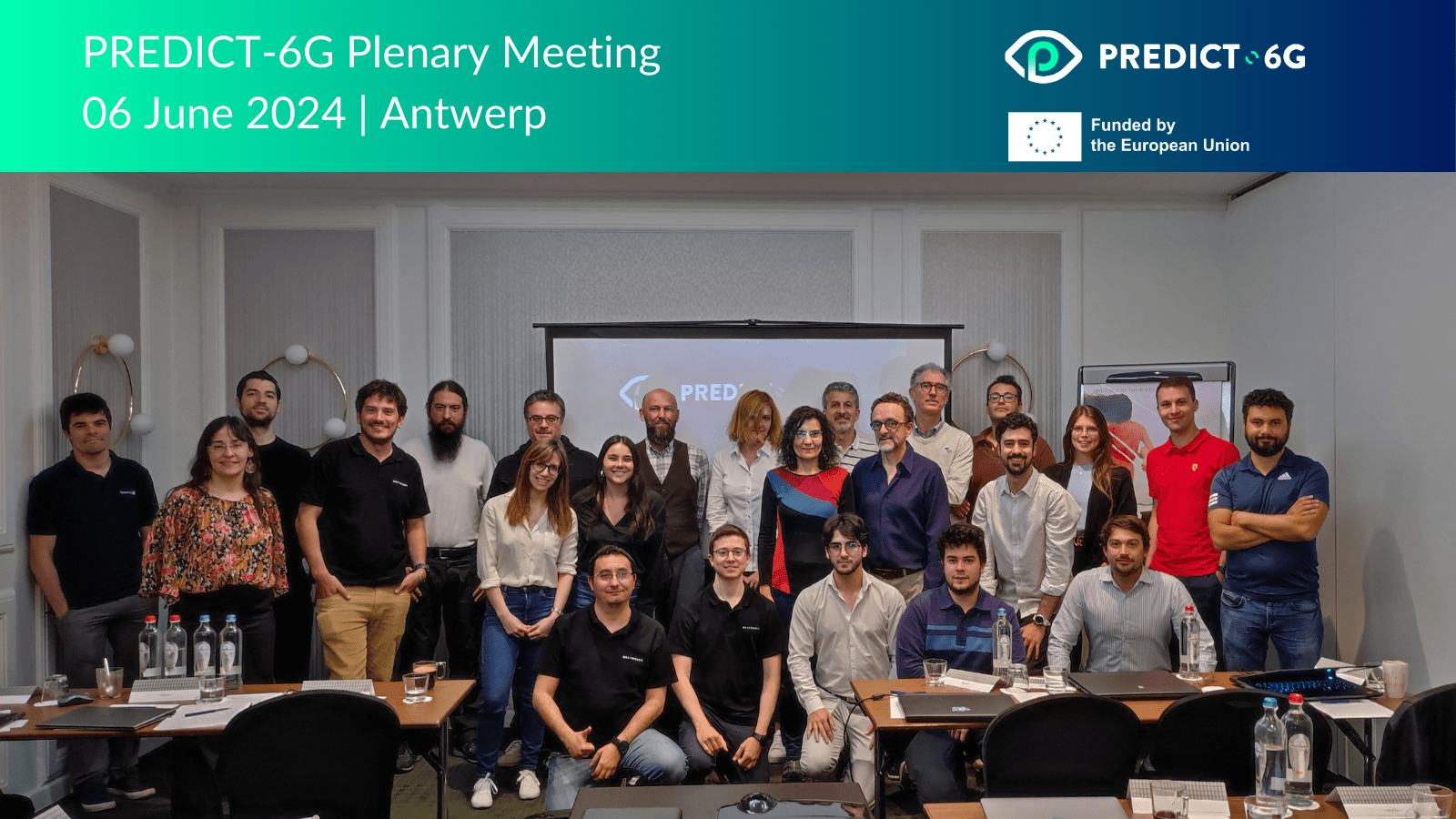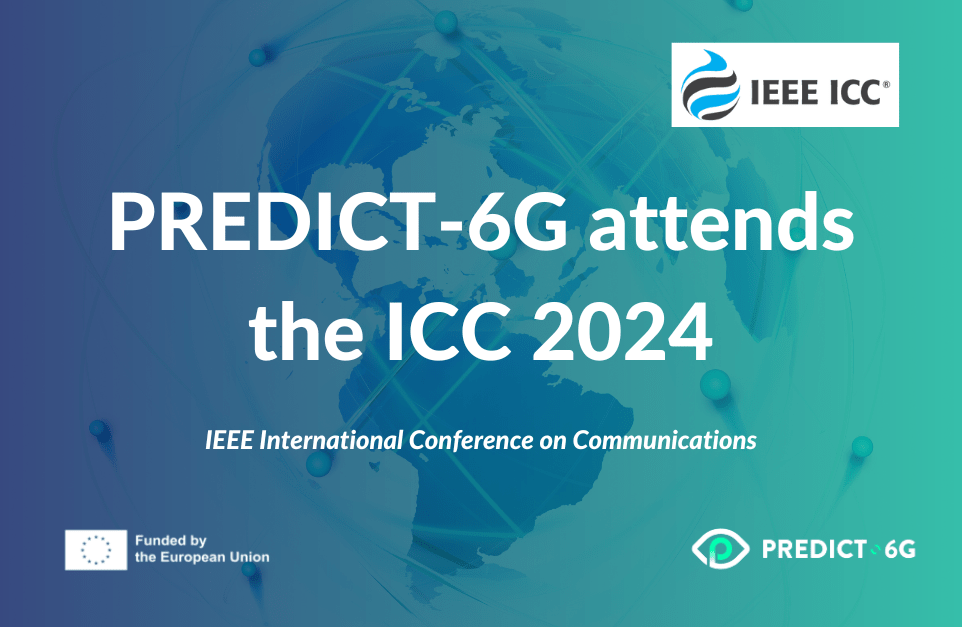PREDICT-6G FAREWELL
With the end of the PREDICT-6G project approaching on 30 June 2025, we asked all our partners what it had been like to be part of the project for almost two and a half years. This is what each partner told us:
Antonio De La Oliva on behalf of Universidad Carlos III de Madrid, PREDICT-6G Coordinator. "As coordinator of PREDICT-6G it has been a pleasure to form part and lead a research project which has advanced significantly the area of determinism in the upcoming 6G network. The research performed, the PoCs developed, and the advance of state of the art achieved will impact next generation networks while, at the same time, training the next generation of network researchers that will shape it. It has been great to work with such an amazing team!"
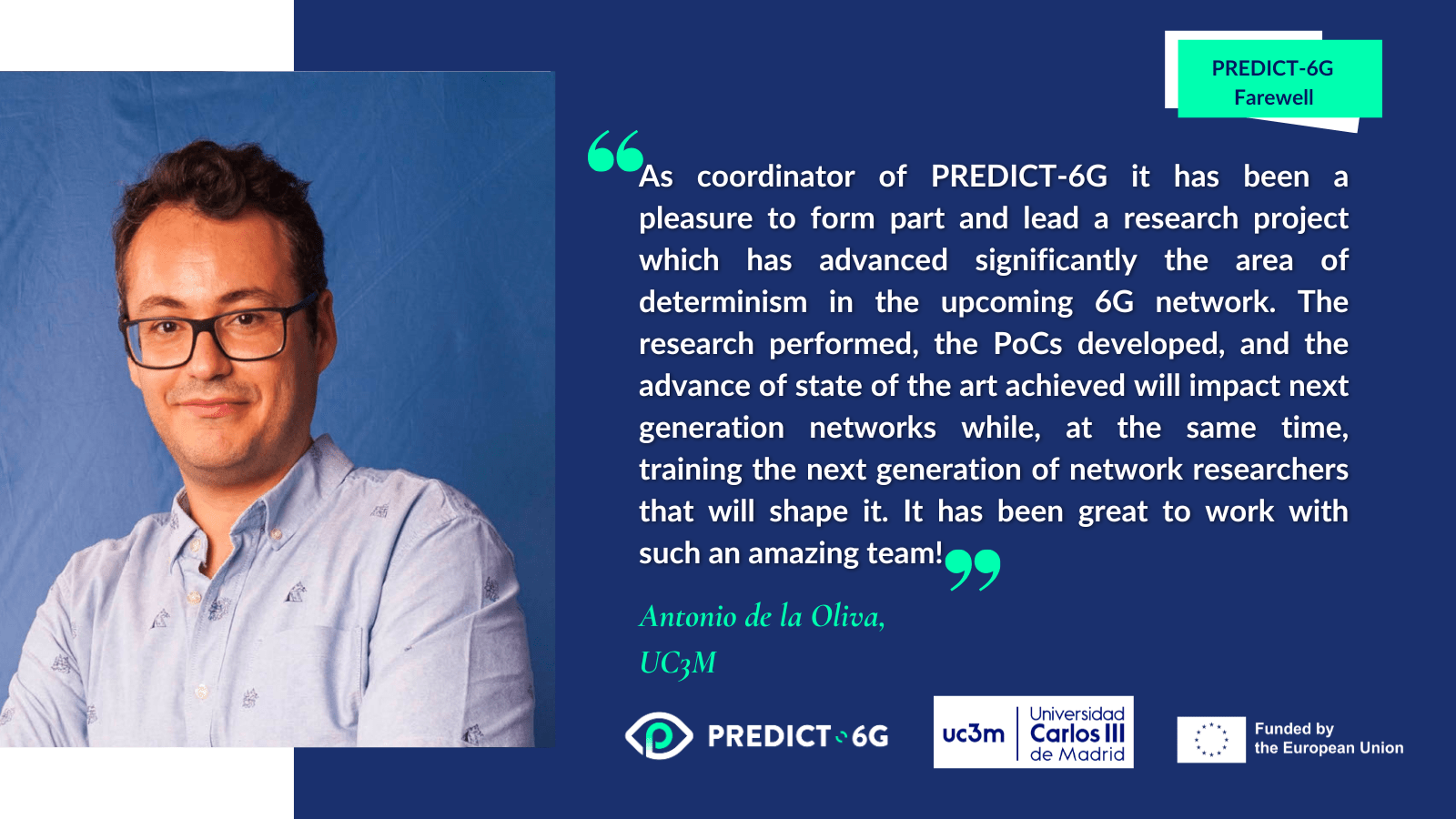
José Luis Cárcel on behalf of Atos, leader of the PREDICT-6G ‘Frictionless inter-domain orchestration and network control’ task. "PREDICT-6G has been an exciting journey for Atos. It has been a great opportunity for us to extend our work on MLOps and Service Automation to help the project achieve the predictability and reliability required to guarantee determinism".
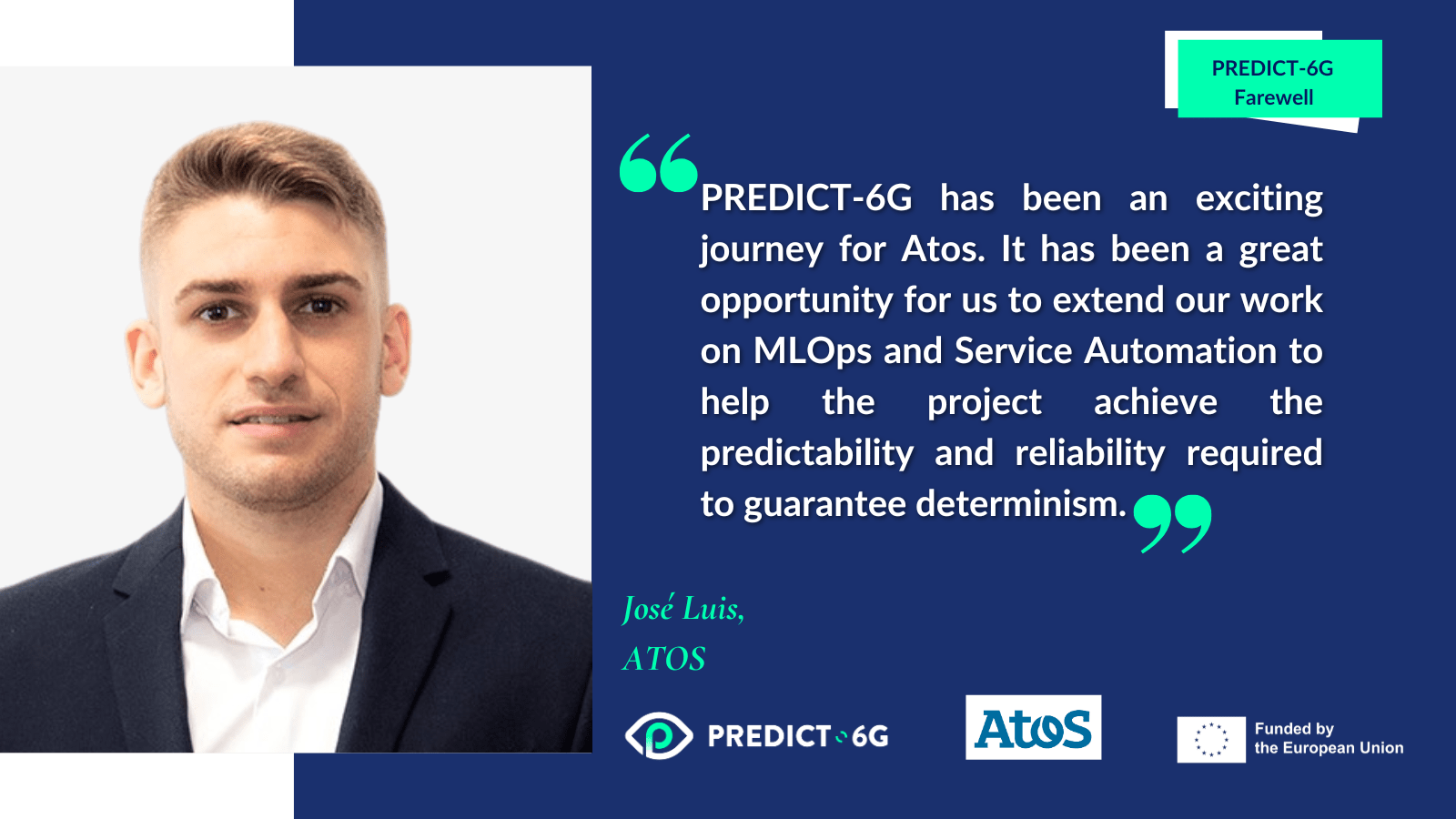
Jessica Carneiro on behalf of AUSTRALO, PREDICT-6G Dissemination and Communication Task Leader."Witnessing the practical application of the PREDICT-6G determinism concept across multiple sectors was enlightening.For AUSTRALO, it was rewarding to creatively translate complex project elements such as AICP or MDP into engaging content that showcased the project's achievements".

Fotis Foukalas on behalf of Cogninn, the partner responsible for overseeing the security aspects of the PREDICT-6G network. "The role of security for PREDICT-6G is important. Cogninn in collaboration with other partners specified secure multi-domain authentication and other security mechanisms for PREDICT-6G type of management architectures for future 6G networks".
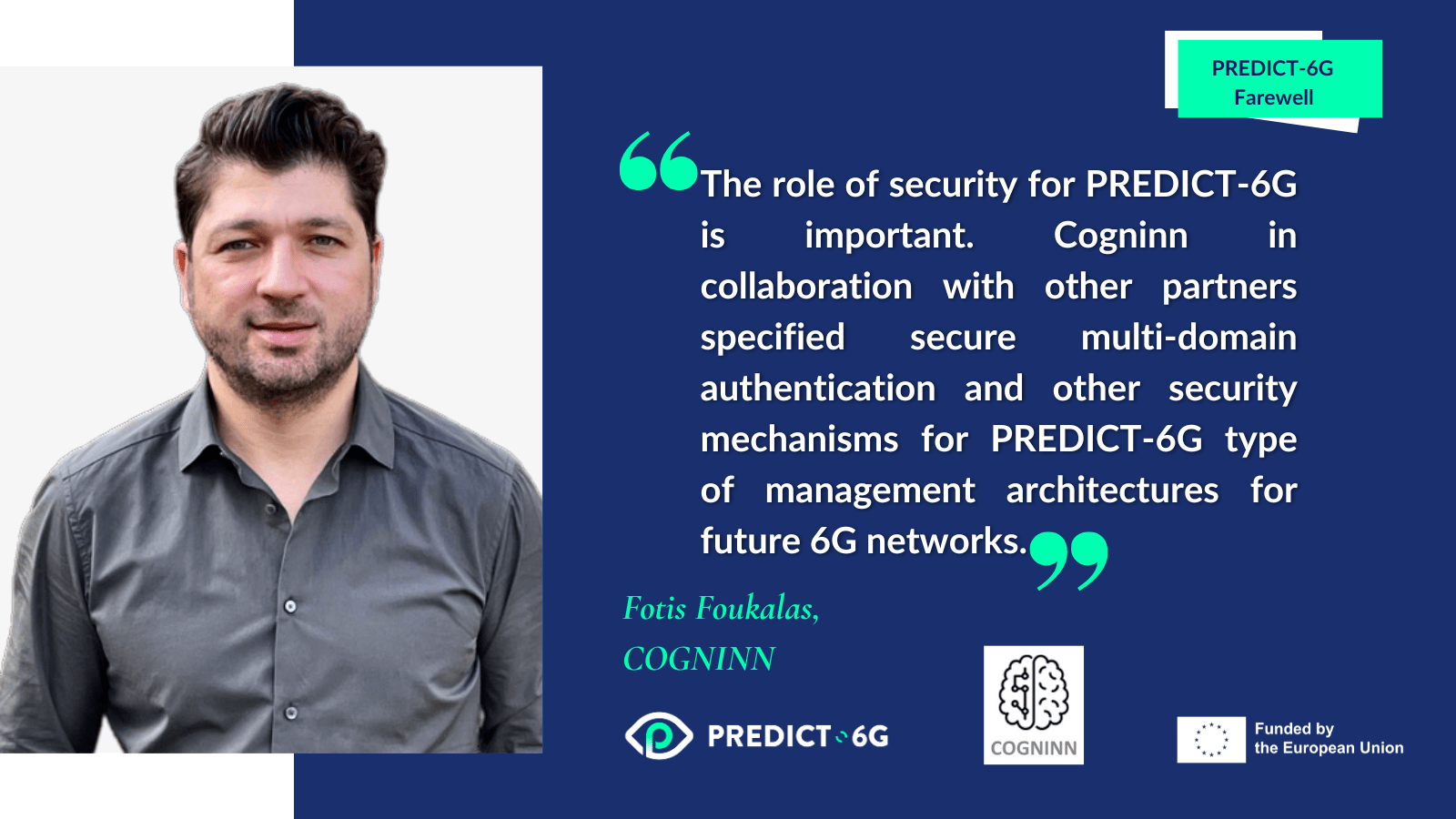
Claudio Zunino on behalf of the Consiglio Nazionale delle Ricerche (CNR). CNR contributed to the development of the core components of the PREDICT-6G network and validated its architecture in a critical use case at the Budapest Open Lab. "The participation in the PREDICT-6G project revealed an exciting and profitable chance. In this context, the CNR team had the opportunity of practically experiencing the usefulness of topics like TSN and SDN, that were formerly only theoretically addressed, and to check the benefits they brought to the determinism requested by the project".
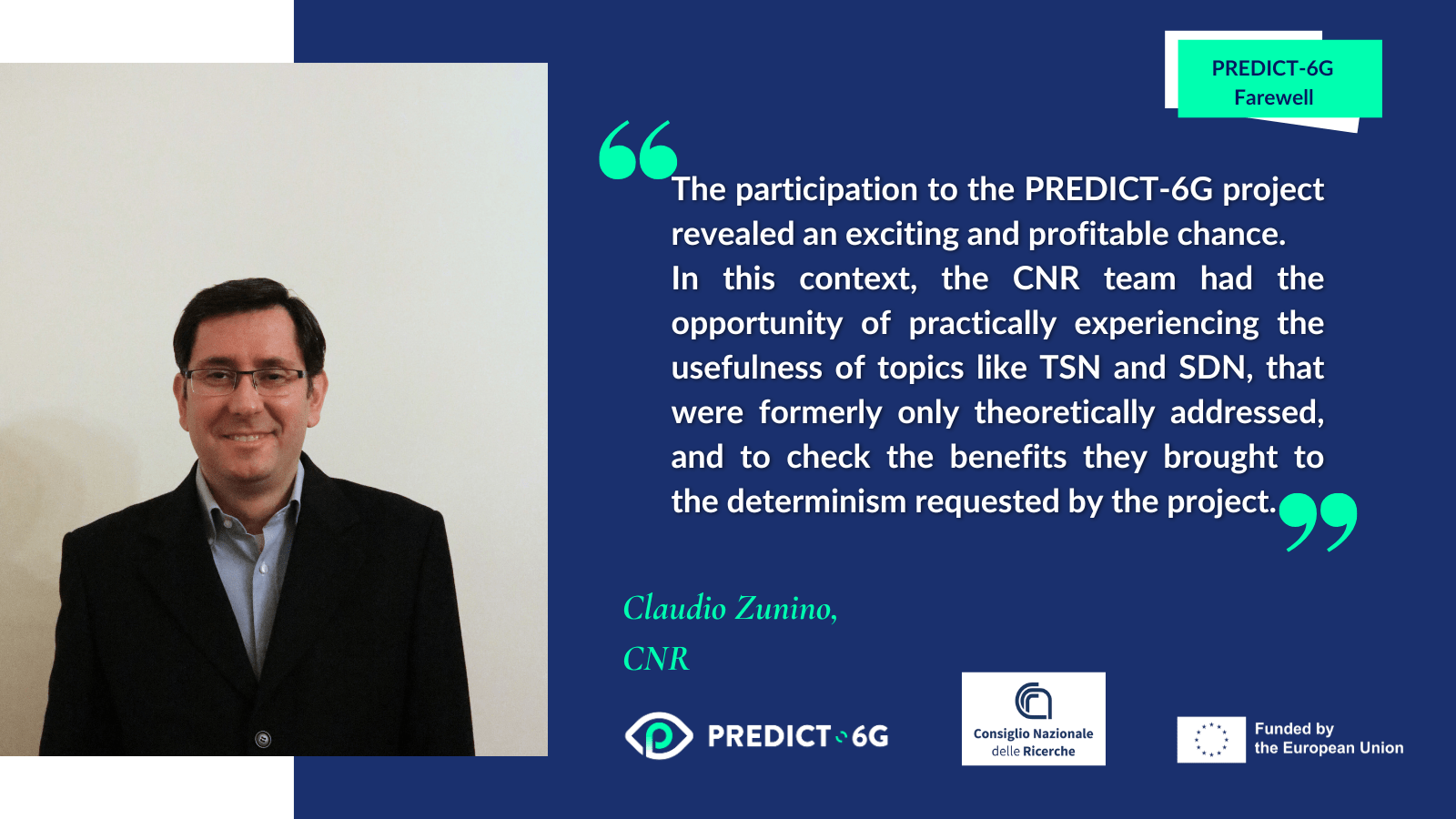
Miguel Ángel López on behalf of Ericsson, leader of the PREDICT-6G Multi-technology multi-domain Data-Plane Work Package. "It has been amazing to see how the PREDICT-6G determinism technologies can impact industry and society. From Ericsson's perspective, we are focused on demonstrating how mobile technologies such as 5G can transform industries that are traditionally wired and where determinism is a must".
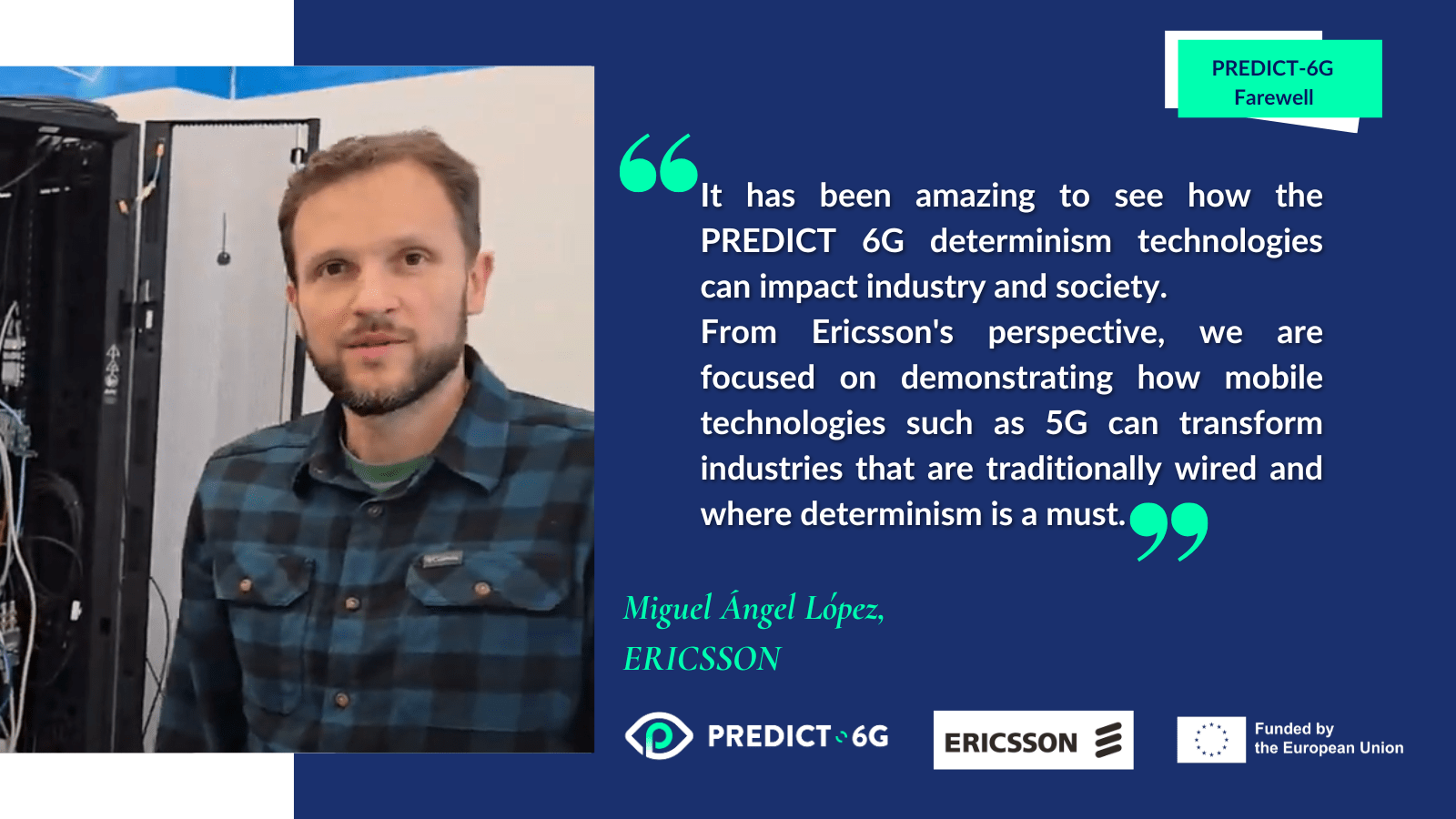
Josu Caminos on behalf of Gestamp, part of the PREDICT-6G Smart Factory use case. "Deterministic wireless communications will be a key foundation in GESTAMP’s upcoming Smart Factories, where virtualization and asset mobility will enable complete flexibility and robustness. PREDICT-6G is one step closer to achieving this milestone, where it has been demonstrated that this technology can meet the demanding requirements from industrial environments".
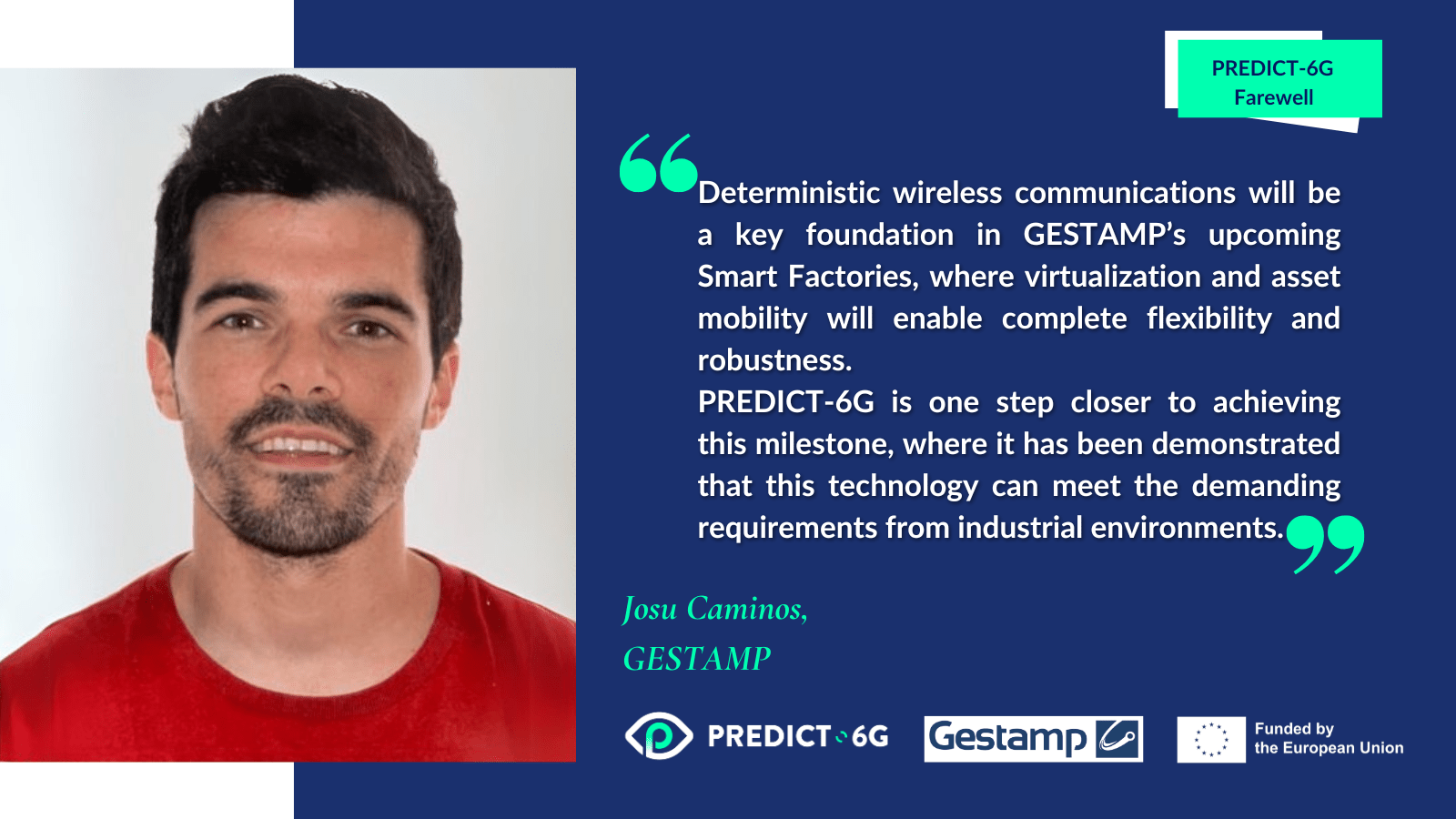
Valerio Frascolla on behalf of Intel, leader of the PREDICT-6G Impact Creation Work Package. "Disciplined Innovation in research projects is key for obtaining outstanding results. That is why Intel is driving the PREDICT-6G Innovation Program, e.g. organizing workshops where fun and learning go hand in hand".
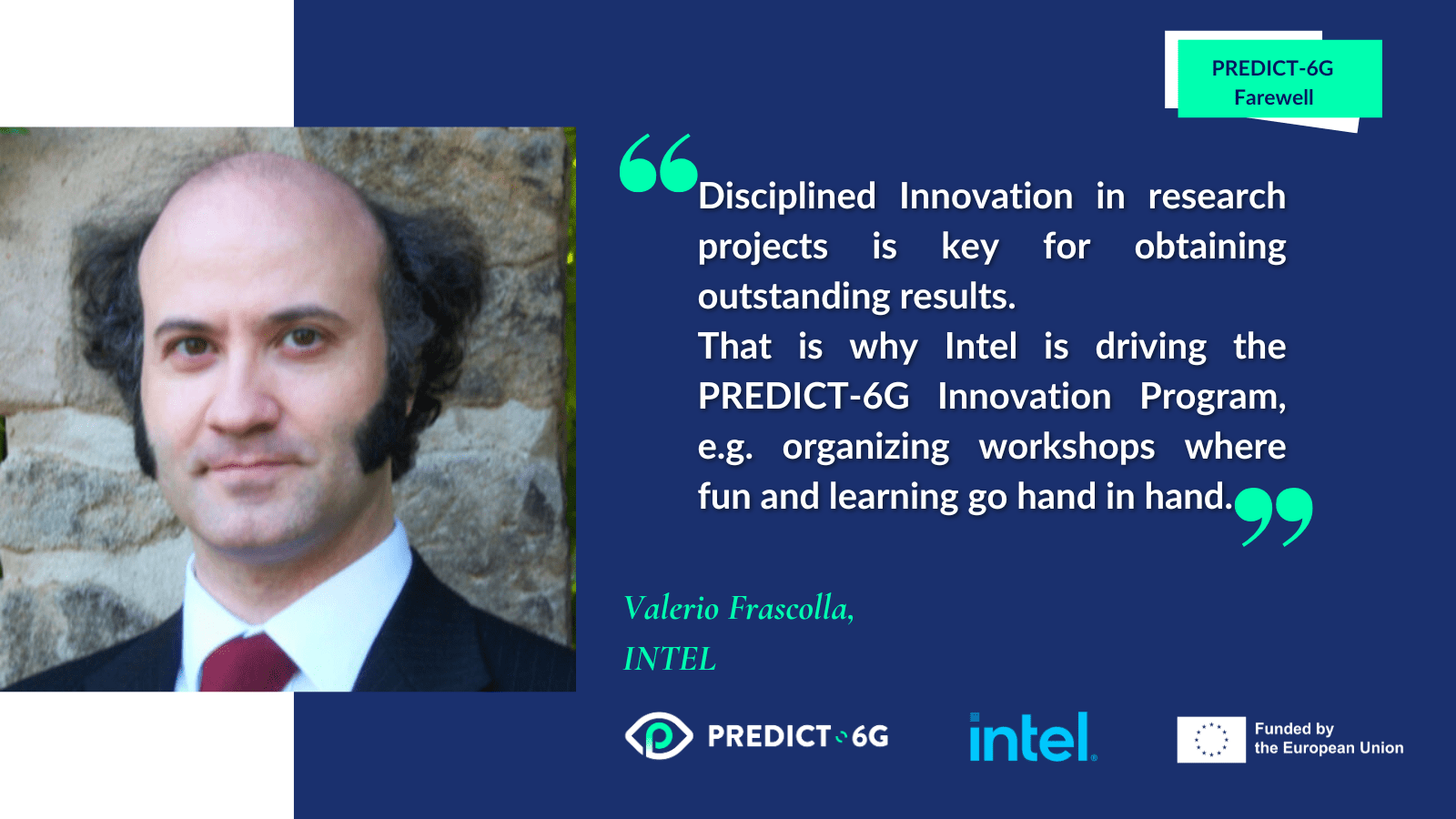
Sebastian Robitzsch on behalf of InterDigital, and responsible for the standardisation of PREDICT-6G. "During the lifetime of the project, we had the opportunity to develop a standards-aligned deterministic IPv6-compliant data plane concept and integrated it successfully with PREDICT-6G partners in a multi-domain localisation and sensing use case".
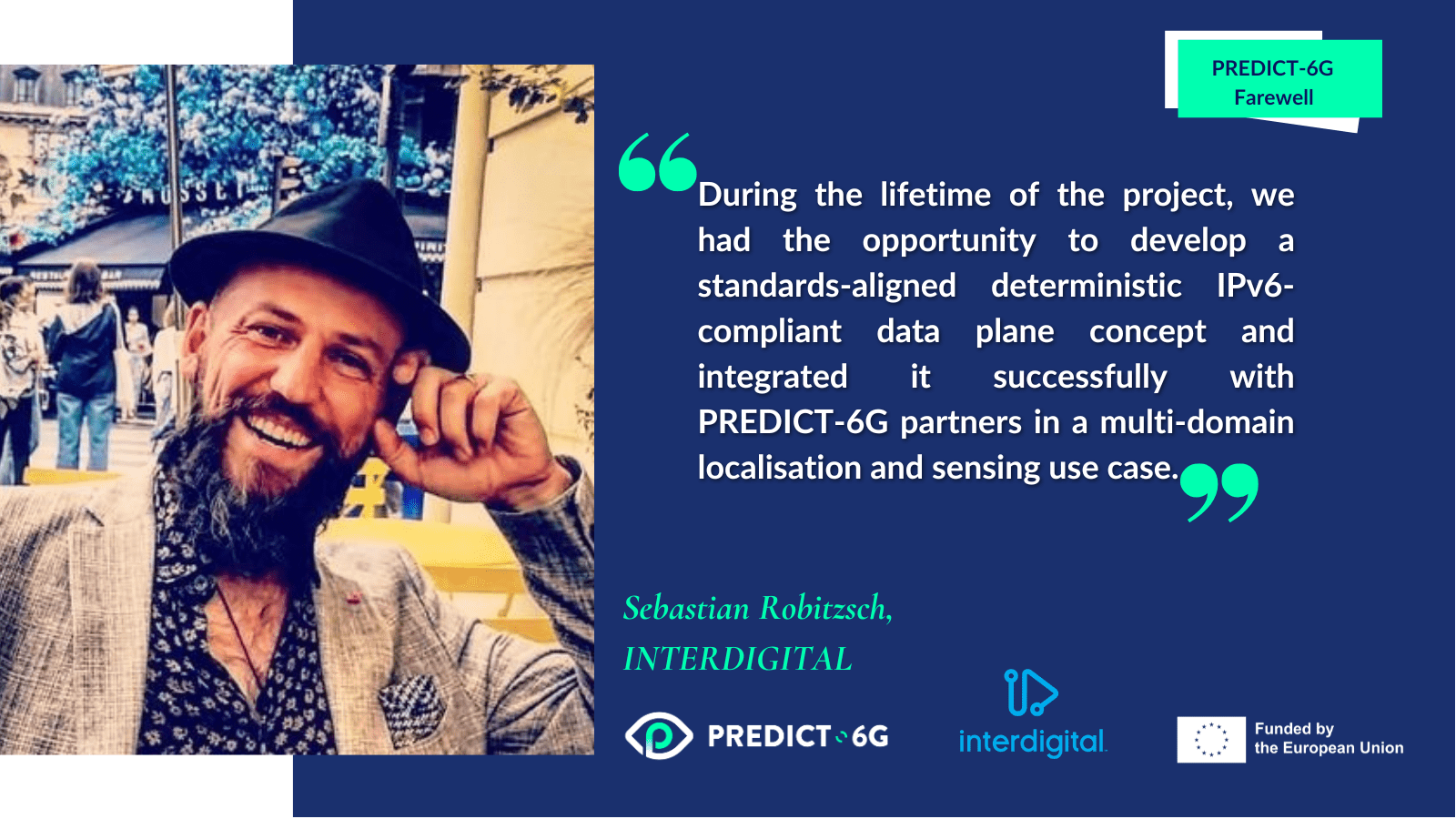
Matteo Ravalli on behalf of Nextworks, PREDICT-6G Monitoring Platform and Data Management for deterministic networks task leader. "The goal of PREDICT-6G has been challenging and working together to achieve it has been exciting. It has been a great chance for Nextworks to improve our Data Collection and Management module with an extended architecture and new features for the monitoring of meaningful metrics from the MDP needed for data-driven network automation decisions".
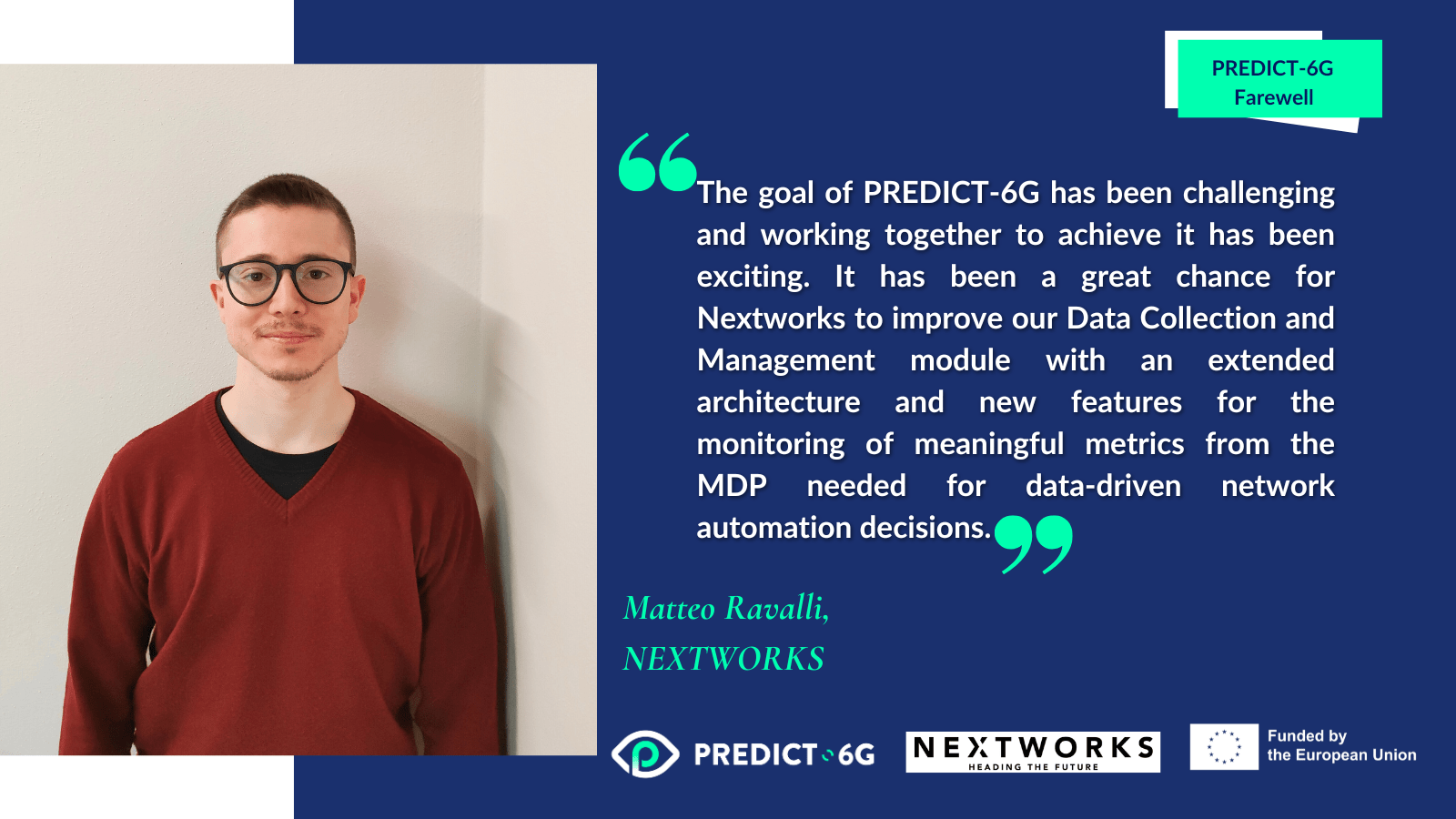
Zoltán Vincze on behalf of Nokia, leader of the PREDICT-6G task called 'definition of the system architecture'. "PREDICT-6G's work was an important step towards enabling use cases requiring deterministic communication. As part of this, we had the opportunity to work on a solution that can improve the level of determinism in networks with no in-built deterministic capabilities, thus making it possible to reuse existing install base of non-deterministic enabled network devices on the path of transitioning to an E2E deterministic-enabled stack".
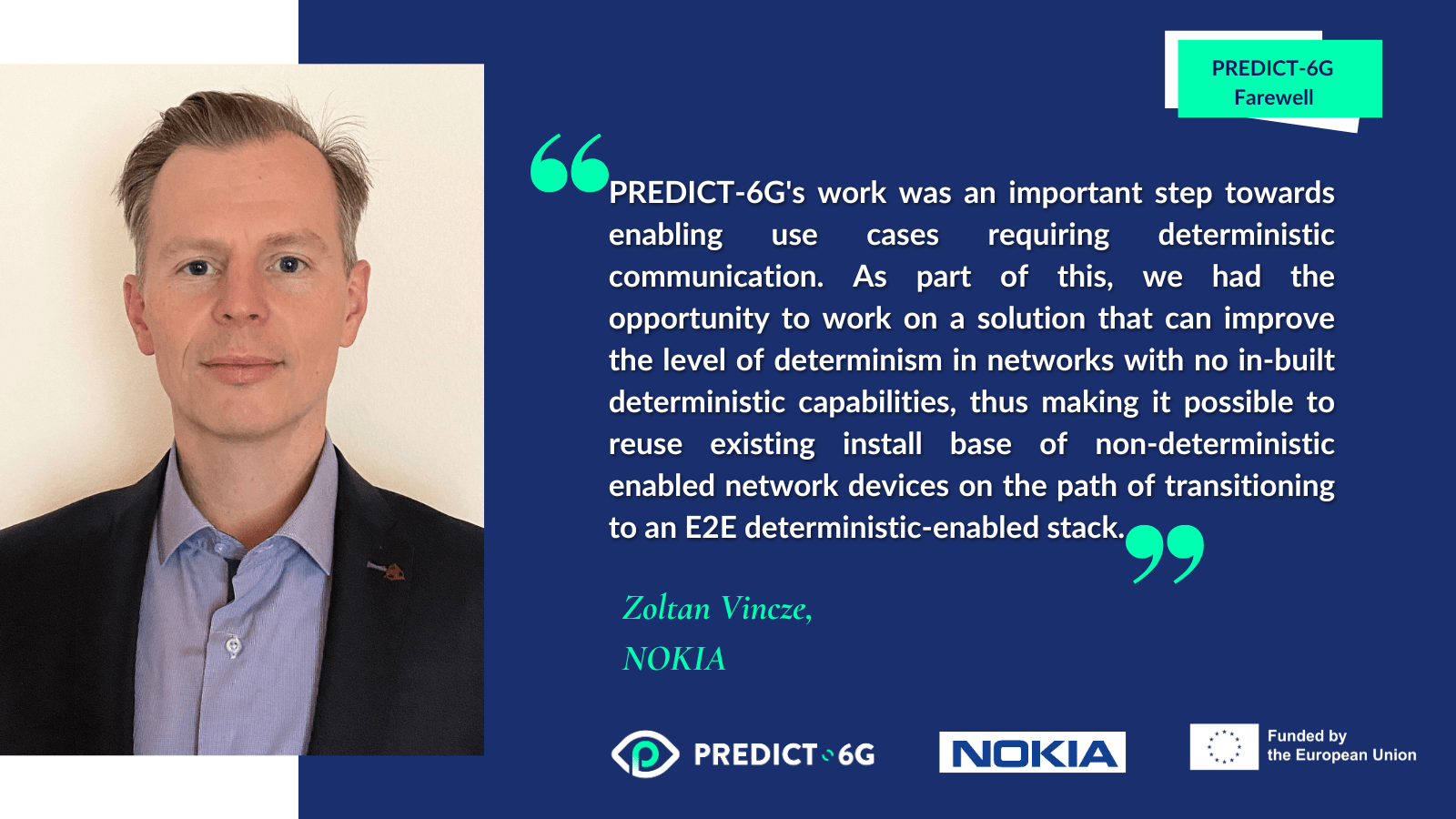
Corrado Puligheddu on behalf of Politecnico di Torino, leader of the PREDICT-6G task called 'Algorithmics for predictability and resource allocation in multi-domain environments'. "At Politecnico di Torino, we are glad to have contributed to PREDICT-6G, tackling the challenge of network determinism in future 6G networks. We are proud that our research efforts show promise for real-world application and hold the potential to create meaningful impact for society".
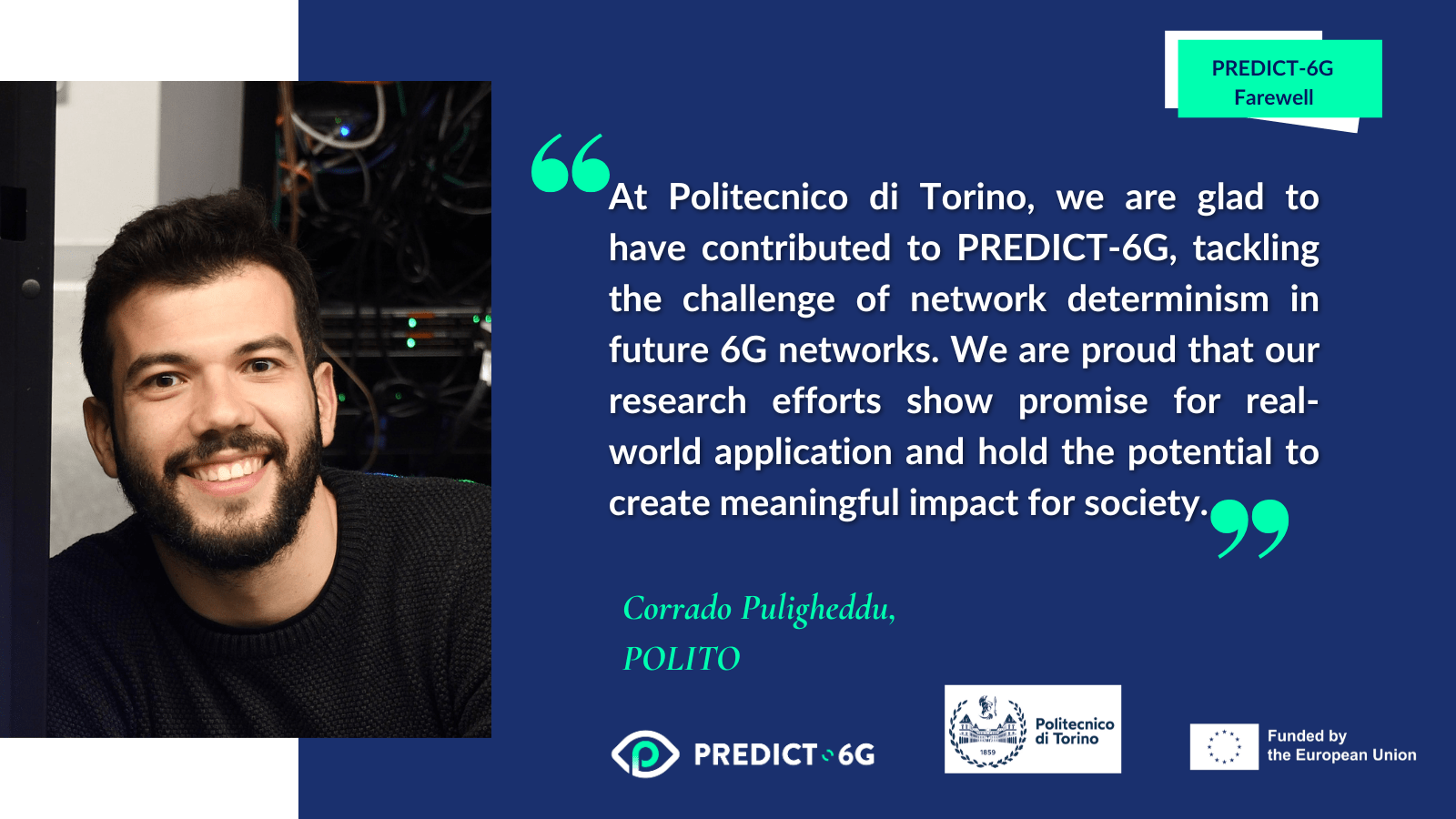
Iacob Crucianu from SIMAVI, and leader of the PREDICT-6G Integration and use case verification Work Package. "As part of the PREDICT-6G project, SIMAVI has proposed a redundancy path framework for deterministic and secured 6G networks. Designing and validating this proof-of-concept, while collaborating with a multidisciplinary team was both challenging and rewarding. Thankful to be part of this space of possibilities!".
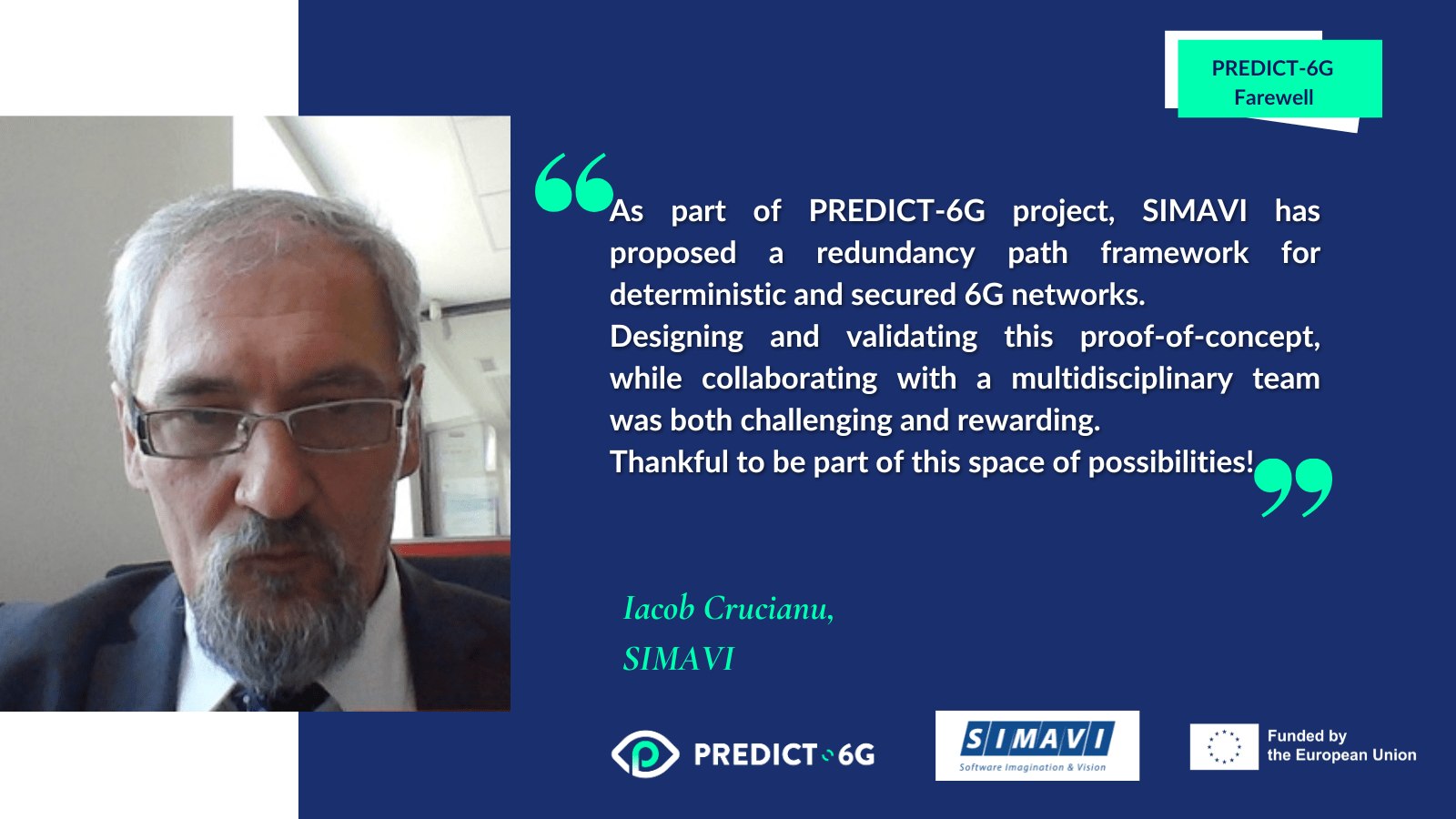
Angelo Cenedese on behalf of Università degli Studi di Padova, a PREDICT-6G partner contributing to the development of the AI-driven multi-stakeholder inter-domain control plane, and to the integration and verification of use cases. "Achieving high performance in multi-device, multi-domain networks requires the co-design of computation, communication, and control across domains. As part of the PREDICT-6G project, UniPD has embraced this integrated approach in the field of mobile robotic applications, paving the way for the development of intelligent, flexible, and scalable networks capable of adapting to and thriving in dynamic environments".

The team from Universitat Politècnica de Catalunya, leader of the PREDICT-6G task called 'Predictability through Digital Twinning Solutions'. "The participation of UPC in Predict6G has been highly valuable, enhancing its research capabilities in deterministic communications, adopting advanced network orchestration and digital twin technologies for industrial automation. It has strengthened academic-industrial collaboration, contributed to scientific advancement, and reinforced UPC’s role in shaping future intelligent, reliable and time-critical systems".
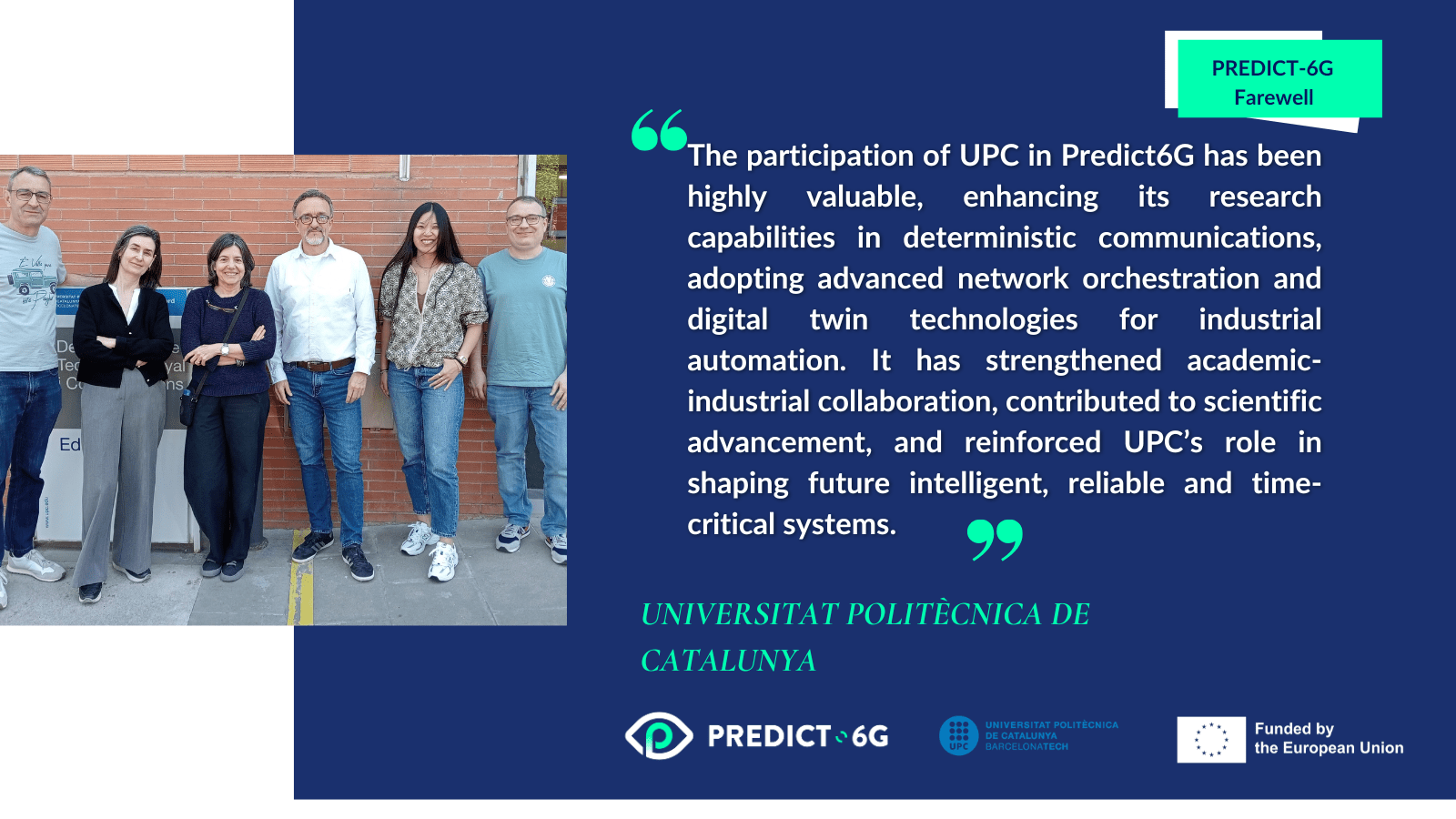
If you want to stay updated about PREDICT-6Gt, subscribe to our newsletter and follow us on Twitter, LinkedIn and Bluesky!
UPCOMING EVENTS
As PREDICT-6G enters its final months, the consortium partners are showcasing the results of the use cases and presenting the latest publications and papers at various events over the coming months. Here is a list so you don’t miss any of the events taking place in 2025.
MPLS & SRv6 AI Net World Congress
The 2025 edition of MPLS & SRv6 AI Net World Congress will take place on 25 - 27 March in Paris, France. The 2025 conference programme will focus on the impact of AI & ML on current infrastructures and services.
Experts will discuss intelligent computing networks, digital twins, software engineering and automation aspects. A large part will be dedicated to IPv6 networks and SRv6 deployments: inter-cluster connectivity, deterministic path placement, IPM hardware connectivity and other key developments. Other sessions will cover IP/optical networks, routing issues, 5G/6G & the edge, latency and security.
Luis Miguel Contreras, technology expert at the Global CTIO Unit from Telefónica, PREDICT-6G partner, will be one of the speakers at the conference. He will participate in the Latency and Performance Measurement session to address the new considerations, such as latency and jitter, required by new services such as VR and AR.
SNS projects join forces in the AI and Security Webinar
In April 2025, PREDICT-6G will participate with several SNS projects in the “AI and Security” webinar. Organised by ELASTIC and CONFIDENTIAL-6G, the online event addresses various aspects of AI and security from different perspectives.
The webinar comprises three main sessions, namely: Privacy and Security in Federated and Distributed AI; AI and Security for Predictive and Resilient Networking; and, Security and Privacy Management in Next-Generation Network Orchestration.
PREDICT-6G partner, Fotis Foukalas from Cognnin, will deliver a presentation titled “Threats and Security Enablers for Predictive 6G Networks”.
Stay tuned for more information!
EuCNC 2025
The 2025 EuCNC & 6G Summit will take place on 3 - 6 June in Poznan, Poland. Combining two successful telecoms conferences: ECNC (European Conference on Networks and Communications), supported by the European Commission, and the 6G Summit, originating from Finland’s 6G Flagship programme, the event is now one of the largest in the sector.
Under the theme 'Towards the 6G World', EuCNC will bring together more than 1000 delegates from over 40 countries around the world and an exhibition with more than 50 exhibitors to demonstrate the technology being developed in this area, notably through research projects from EU R&I programmes. One of these projects will be PREDICT-6G, as we are returning for the third year in a row.
Save the date and stay tuned for more information on this event!
If you want to stay updated about PREDICT-6Gt, subscribe to our newsletter and follow us on Twitter, LinkedIn and Bluesky!
Integration Week at 5Tonic Open Lab
From 20 to 24 January 2025, PREDICT-6G held the first Integration Week of the project at the 5Tonic Open Lab in Madrid.
In parallel with the first plenary meeting of 2025, held at the Universidad Carlos III de Madrid (UC3M), PREDICT-6G research and technical partners immersed into a week of work focused on implementing the theoretical framework developed in the past years. The activities were carried out in the 5Tonic Open Lab in Madrid, one of two Open Labs where PREDICT-6G use cases are being tested..
In the final stages of the project, the priority is to seamlessly integrate the various elements comprising the deterministic, secure, modular and interoperable 6G network of PREDICT-6G. For this purpose, partners from Universidad Carlos III de Madrid, Nextworks, Atos, SIMAVI, Universitat Politècnica de Catalunya, InterDigital, Ericsson and Telefónica worked together in the MDP and AICP integration and its application in deterministic communications and smart manufacturing.
As part of the Integration Week activities, some of the partners recorded short tutorials on the work developed during these days.
AICP Integration
Alejandro Calvillo, researcher at UC3M, explains what they have done in terms of AICP integration
Smart Factory use case
Miguel Ángel López Serrano, System Manager at Ericsson, explains the progress they are making in the 'Smart Factory' Use Case.
Multi-Domain use case
David Rico, a PhD student and researcher at UC3M, explains the progress they are making in the 'Multi-Domain' Use Case.
If you want to stay updated about PREDICT-6Gt, subscribe to our newsletter and follow us on Twitter, LinkedIn and Bluesky!
A European Vision for 6G
The "European Vision for the 6G Network Ecosystem" white paper, authored by the 6G-IA Vision Working Group, of which PREDICT-6G is an active member, was published in November 2024.
The paper outlines the ambitious trajectory for developing, standardising, and implementing 6G networks, targeted for a commercial rollout by 2030. As the world prepares for the next leap in communication technology, Europe is a driving force in the future 6G networks, proactively addressing the technological, societal, and sustainability challenges.
What Makes 6G Different?
6G promises to revolutionise how we connect, communicate, and interact with the world around us. Integrating Artificial Intelligence (AI) will enable smarter and more responsive systems, whilst advanced technologies, such as sensing and communications (ISAC), will allow 6G devices to go beyond mere communication to sense their surroundings for real-time applications such as autonomous driving and healthcare monitoring.
"Sustainable 6G and 6G for sustainability"
6G aims to reduce the environmental impact by improving energy efficiency and incorporating circular economy principles. 6G networks will be sustainable by design while helping other industries reduce their carbon footprints. Addressing the socioeconomic and environmental challenges through advanced connectivity is a priority.
Groundbreaking innovations
Europe’s vision for 6G identifies six key areas of innovation:
- Immersive Experiences: attending meetings or events will feel like being onsite, thanks to augmented and virtual reality powered by ultra-fast, low-latency networks.
- Collaborative Robots (CoBots): robots will work alongside humans in farms, factories or hospitals, using real-time communication and AI to enhance efficiency and safety.
- Surroundings awareness: 6G enables scene analysis, supporting safer and smarter mobility, by avoiding collisions or improving traffic flow.
- Digital Twins: real-time, interactive virtual replicas of physical systems, such as factories or cities, will enable better monitoring, control, and simulations in real time.
- Ubiquitous Connectivity: 6G aims to connect even the most remote areas, ensuring everyone can access the digital world.
- Trustworthiness: enhanced privacy, security and reliability will enable applications like precision healthcare and public safety.
Europe’s Leadership in 6G Development
The paper stresses the importance of global consensus on 6G standards while acting locally. By combining cutting-edge R&D with a focus on sustainability and inclusivity, Europe aims to lead the global race to 6G while fostering positive impacts across industries and communities.
The journey to 6G is about more than just faster internet speeds. It is about creating smarter, greener, and more inclusive technologies that transform industries and improve lives. As Europe paves the way, the focus remains on collaboration, innovation, and ensuring that 6G serves as a tool for positive change across the globe.
The future of connectivity is closer than you think!
If you want to stay updated about PREDICT-6Gt, subscribe to our newsletter and follow us on Twitter, LinkedIn and Bluesky!
6G Programmable Deterministic Webinar Series #2: Summary and Recording Available
The second round of the 6G Programmable Deterministic Webinar Series took place on 22 October 2024, under the title 'Enhancements towards management of time-sensitive networks’.
The 6G Programmable Deterministic Webinar Series: #2 Enhancements towards management of time-sensitive networks brought together 90 participants, from researchers to industrials, across 25 different countries. More than 20 SNS projects attended the webinar.
The session started with a presentation about wireless-friendly TSN scheduling by Frank Dürr, Simon Egger and Lucas Haug from the University of Stuttgart and members of DETERMINISTIC-6G. Sandor Laki, from Elte and part of DESIRE-6G, delved into the topic of resource sharing policy enforcement in access aggregation networks. Dave Cavalcanti from Intel and member of the PREDICT-6G project, closed the presentations speaking about wireless-aware TSN configuration and management.
An animated discussion with the audience wrapped the agenda. The webinar was moderated by Raheeb Muzafar, Senior Scientist Wireless Communications at Silicon Austria Labs and part of DETERMINISTIC-6G.
The recording of the seminar is available here or below.
The 6G Programmable Deterministic Webinar Series is a collaborative initiative between PREDICT-6G, DESIRE6G and DETERMINISTIC6G, aiming to delve into the intricate and transformative aspects of these sister projects, with expert speakers exploring the latest developments and innovations shaping the future of 6G technology. Each session will provide in-depth information and foster key discussions for practitioners and researchers working on the next generation of wireless communications.
If you want to stay updated about PREDICT-6Gt, subscribe to our newsletter and follow us on Twitter, LinkedIn and Bluesky!
PREDICT-6G Plenary Meeting at Nokia Bells Lab in Budapest
The premises of Nokia in Budapest were the scenario of the last PREDICT-6G Plenary Meeting. The consortium partners gathered in the Hungarian capital for two days of intense work that would define the next steps for the coming months.
During the 15-16 of October 2024, PREDICT-6G held its latest plenary meeting hosted by Nokia Bells Lab in their Budapest office – Nokia Skypark. The agenda kicked-off with a review of the current status of the project. All the work package coordinators, with the support of the task leaders, presented an overview of their activities and achievements, as well as the upcoming milestones. Partners had the opportunity to provide insightful inputs to progress the planned activities as well as to ensure a smooth alignment amongst them. A dinner organised by the host in a boat in the Danube put the perfect end to the day.
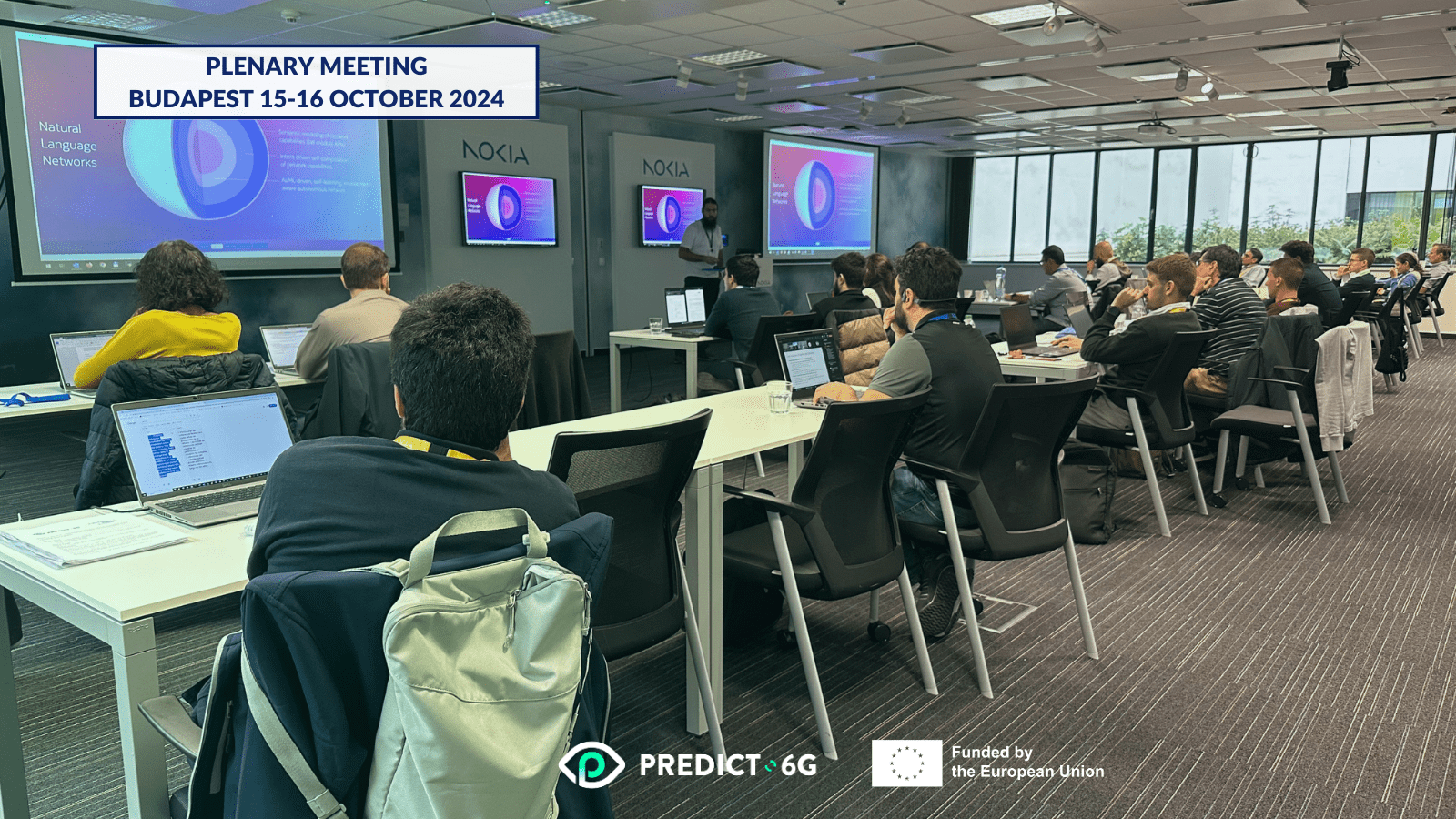
The dedicated discussions around the Data Plane and the Control Plane were the focus on the second day. Furthermore, some new exciting demos were displayed for all attendees. The collaboration of PREDICT-6G with different SDOs and the SNS and 6G-IA working groups, the participation in a number of relevant events and the status of several papers were also addressed.
The Plenary was highly productive, with a positive outcome on the status of the project and a clear roadmap for the next months. It also provided a new chance to continuing to strengthen the collaboration amongst partners. Madrid will be the next stop in January 2025!
If you want to stay updated about PREDICT-6Gt, subscribe to our newsletter and follow us on Twitter, LinkedIn and Bluesky!
Upcoming events
PREDICT-6G is entering its last year and the consortium partners are showing the progress in the project, presenting the latest publications and papers in several events that will take place in the coming months. Here is a list so you do not miss any of them.
ICTON 2024
The International Conference on Transparent Optical Networks (ICTON) 2024 will be held from 14 to 18 July in Bari, Italy. The conference and side events will focus on applications of transparent and all-optical technologies to telecommunications, computing, sensing and quantum applications. Luis Miguel Contreras from Telefonica will present the paper “Reliability in deterministic networks: Comparison of FRER (TSN) and PREOF (DetNet)”, related to the research carried out within the project. The publication is available here.
PIMRC 2024
IEEE International Symposium on Personal, Indoor and Mobile Radio Communications (PIMRC) will take place 2-5 September in Valencia, Spain. Under the theme “Elevating 6G Beyond Connectivity”, PIMRC is one the flagship conferences for IEEE Communications Society with a special focus on cutting-edge wireless technology research and innovations. Professor Carla Fabiana Chiasserini from Politecnico di Torino will attend the conference to present the paper “Target Wake Time Scheduling for Time-SensitiveNetworking in the Industrial IoT”.
ETFA 2024
The 29th IEEE International Conference on Emerging Technologies and Factory Automation, (ETFA) 2024, will take place from 10 to 13 September in Padova, Italy. It brings together professionals from industry and academia to share cutting-edge concepts, recent developments, research results, and practical achievements in industrial and factory automation. The key goal is to foster the enhancement and application of scientific techniques, models, and tools that support the efficient design and operation of industrial and factory automation systems. PREDICT-6G consortium members, CNR and Intel will be at the Conference to present the paper “Time-Sensitive Networking and Software-Defined Networking: an experimental setup for realistic performances”.
IEEE HPSR
The 2024 IEEE 25th International Conference on High Performance Switching and Routing (HPSR) will be held 22-24 July in Pisa, Italy. The main focus of the HPSR 2024 will be to assess how breakthrough changes occurring to networks and telecom are affecting areas related to switching and routing, and communication networks in general. Nextworks, a member of the PREDICT-6G consortium, will be present at HPSR with a booth promoting the project with a poster and a screening of the joint demo with InterDigital: Monitoring Data collection Integration with a Sensing-Enabled 3GPP Technology Domain. You can watch the demo here.
If you want to stay updated about PREDICT-6G, subscribe to our newsletter and follow us on Twitter and LinkedIn!
Call for papers: MobiCom 2024
In the scope of the MobiCom 2024 -The Annual International Conference on Mobile Computing and Networking- which will be held on the 18-22 of November in Washington DC, DESIRE6G, DETERMINISTIC6G and PREDICT-6G will co-organise the 2nd workshop on 6G Programmable Deterministic Networking with AI (6G-PDN 2). In preparation for the workshop, the projects have launched a call for papers that contribute to the advancement of 6G network research.
The objective of this workshop is to discuss the roadmap and challenges in the technology areas of deterministic communications and deep network programmability in 6G to support future end-to-end time-critical applications. It also aims to bring together academic and industry researchers to stimulate discussions, introduce news ideas and technical solutions in the aforementioned areas and therefore contribute to the progress of 6G networking research.
Submitted papers may cover any of the following topics:
- Programmable data planes for TSN.
- Enhancements towards 6G TSN and DetNet integration.
- Network softwarization for 6G.
- Programmable networking protocols.
- Programmable SDN and NFV: languages and architectures (P4 and others).
- Hardware acceleration for programmable network functions.
- Multitenant data planes.
- Orchestration and management of software-defined deterministic networks.
- Control and management of data plane programmable devices.
- Artificial intelligence for deterministic networks.
- In network machine learning.
- In-network service level tuning and optimization; QoS.
- High precision traffic monitoring/telemetry.
- Service assurance and fulfilment programmability.
- Slicing for 6G.
- Intent-based systems and digital twinning applied in 6G.
- Routing and scheduling algorithms for reliable and real-time IoT.
- Trustworthy edge and cloud computing architectures and services.
Paper Submission deadline is August 15, 2024
You can read all the detailed information here.
If you want to stay updated about PREDICT-6G, subscribe to our newsletter and follow us on Twitter and LinkedIn!
PREDICT-6G's plenary meeting in Antwerp
On the 6th of June, the PREDICT-6G Consortium gathered for its first plenary meeting of 2024 in Antwerp, Belgium.
Taking advantage of PREDICT-6G's presence at the EuCNC & 6G Summit, which took place in Antwerp from 3-6 June, the consortium decided to hold a one-day plenary meeting. This is the first plenary meeting of 2024, just after the mid-term review of the project with the European Commission and almost a year and a half after the start of the project, a date that undoubtedly marks a turning point between what PREDICT-6G has achieved so far and what we want to achieve by the end of it.
The meeting was very productive. The consortium reviewed the status of the work packages, with particular emphasis on those that by their technical nature constitute the core of PREDICT-6G. The integration of the feedback received during the mid-term project review was also further discussed, which together with the exchanges in the plenary meeting about various aspects of the work ahead, yielded a clear roadmap for the last year of the project.
The PREDICT-6G consortium will meet again in the autumn to further advance the common goal of creating a secure, modular, interoperable, and extensible 6G deterministic network.
If you want to stay updated about PREDICT-6Gt, subscribe to our newsletter and follow us on Twitter and LinkedIn!
PREDICT-6G attends the ICC 2024
The IEEE International Conference on Communications (ICC) 2024, focused on “Scaling the Peaks of Global Communications”, took place on 9-13 June 2024 in Denver, Colorado, United States of America.
PREDICT-6G was at the "Edge Learning Over 5G Mobile Networks and Beyond" workshop, which featured two notable keynotes. Aylin Yener, professor at Ohio University, focused on how the Wireless Medium can be exploited to improve Federated Learning, whilst Julien Forgeat, from Ericsson, shared valuable insights into research directions on Distributed Learning from an industry perspective.
Ericsson delivered another interesting presentation focusing on Multi-task Learning for AI-native Radio Access Network. The other presentations primarily focused on Federated Learning, covering some relevant aspects such as model selection, model aggregation and Over-the-Air computation.
Giuseppe Di Giacomo, from Politecnico di Torino (POLITO), presented the paper “Generosity Pays Off: A Game-Theoretic Study of Cooperation in Decentralized Learning". This research, which introduces an incentive mechanism for cooperation in Decentralized Learning, was orthogonal to such works, which still highlighted the need to address the challenge of incentivizing cooperation. During the event, di Giacomo also had the opportunity to engage in stimulating discussions with other PhD students and researchers about the future of Decentralized Learning.
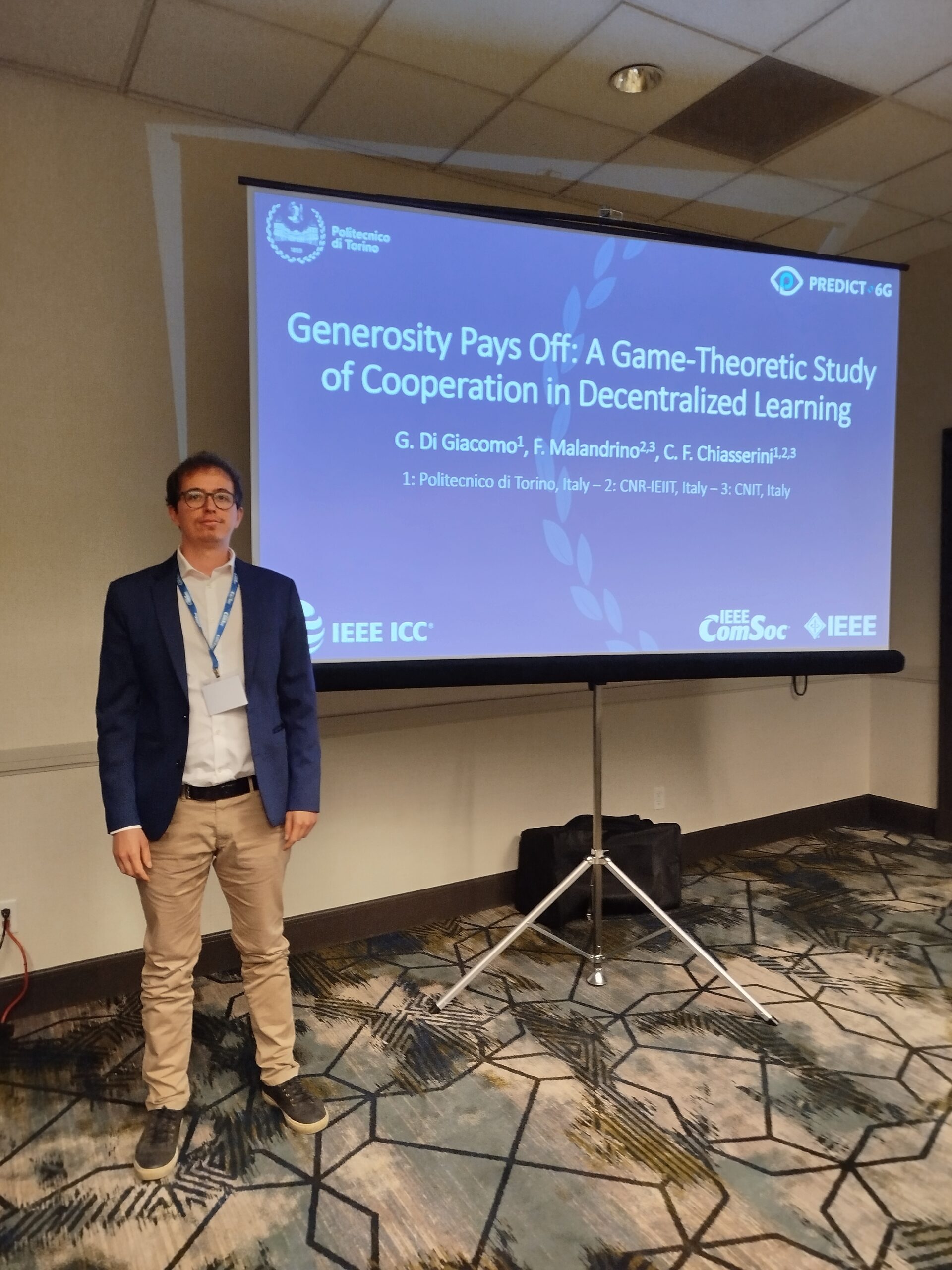
The IEEE International Conference on Communications (ICC) is one of two IEEE Communications Society’s flagship conferences (ICC and Globecom). Each year, close to 2,000 attendees from the industry and academia attend IEEE ICC to learn about the latest research and innovations in communications and networking technology, share ideas and best practices, and collaborate on future projects.
If you want to stay updated about PREDICT-6G, subscribe to our newsletter and follow us on Twitter and LinkedIn!

